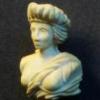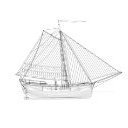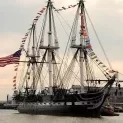-
Posts
2,020 -
Joined
-
Last visited
Reputation Activity
-
 tlevine got a reaction from archjofo in NRG Rigging Project by tlevine - FINISHED
tlevine got a reaction from archjofo in NRG Rigging Project by tlevine - FINISHED
Cleats are located outside both quarter blocks. The length of the cleat is 125% the diameter of the yard. The easiest way to make two identical cleats is to glue two pieces of the correct width wood together with PVA. Shape them and then dissolve the bond in isopropanol. The cleats were glued to the yard outside the quarter blocks.
There are three more blocks on each side of the yard: two buntline and one clueline. These are single blocks and are stropped just as was done with the quarter blocks except the strops are not served. I used 3 mm single blocks for them. Because these strops are not served, it was easier to make an eye-splice on each end to form the loops, just as was done for the futtock shrouds (minus the thimble). As with the other blocks, the strop seizing is on the fore side of the yard. The buntline blocks point skyward and the clueline blocks downward, as seen below.
I have temporarily inserted the pin connecting the mast and yard. The pin passes between the turns of the double strop of the jeer block.
-
 tlevine got a reaction from Kingspoke in NRG Rigging Project by tlevine - FINISHED
tlevine got a reaction from Kingspoke in NRG Rigging Project by tlevine - FINISHED
The mast cap has two openings: a round one for the topmast and a square one for the lower mast head. There are four eyebolts that extend all the way through the mast cap. I raided my scrap box for a contrasting color piece of wood. Both openings were made with a regular drill. The square opening was then shaped with a chisel and the round one was enlarged with sandpaper wrapped around a dowel. It will not be installed until much later.
Although it also will not be installed for a while, I made the topmast next. The dimensions of the topmast are determined by the diameter of the lower mast. The lower end of topmast is 7/10 the diameter of the mast and the upper end is 11/20. This will be a stub topmast as the actual length of this mast would be 8” on the model. Its shape is more complicated than the lower mast. The lowest section (the block) is octagonal, the next section is (the heel) square, followed by another octagonal section. The upper part of the topmast is round, tapering as it goes to the head. There are three openings in the mast; the middle one is for the fid (the rectangular peg which prevents the mast from falling between the trestle trees) and the other two are for sheaves. The kit will contain a template for the topmast.
Starting with a ¼” square dowel, I marked out the mast for the various transition points. Using the 7:10:7 ratio for determining the corners of the octagon, I drew the lines for those two sections. The mast taper begins at the end of the upper octagon. The blue line is the centerline and the red lines are the corners of the octagons. Just as was done for the main mast, I taped off the square section to protect it from errant chisel cuts. The pictures shows a completed topmast above a square dowel. There is extra wood on the top and bottom of the dowel for ease of handling.
I used a saw to cut a shallow groove between the octagonal and square areas on the corners of the square section (circled area). This transition should stay sharp. The lower octagonal section was shaped with a sanding stick.
The upper octagon and round area were both shaped as octagons, without any taper.
Another piece of tape was used to protect the upper octagon and the upper part of the mast was rounded and tapered.
After removing the tape, the transition between the octagonal and round sections and between the square and upper octagonal sections were smoothed.
Making the holes for two sheaves and the fid was next. The upper and lower sheave openings are in the octagonal sections and are 90 degrees to each other and 45 degrees to the fid hole. The dimensions for the fid opening are one-third the mast diameter high and one-quarter the mast diameter wide, in this case 3” x 2.5”. The opening was formed from multiple drill holes, squared off with a #11 blade. The fid was made slightly smaller than the size of the opening and long enough to span the trestle trees.
The sheave openings are 8” long and 1.5” wide. I simulated the sheaves on this model. These were trickier to drill accurately because they are on angled faces. Here is how I made them. The sheave opening was marked on both sides of the mast. I put the mast in a vise, clamping it in the upper octagonal area, just above the sheave opening. A small hole was drilled near the top and bottom of the sheave opening but I did not drill completely through the mast. The mast was repositioned in the vise and the holes on the other side were drilled. The holes on each side were enlarged to the correct width of the opening. I did this slowly, working a little bit on one side and then switching to the other side. The holes eventually met. Then, using a #11 blade, a shallow groove representing the sheave was formed between the two holes and the “sheave” was painted. The final step was to cut off the excess wood at the top and bottom of the topmast and apply a finish.
This is how it looked installed.
-
 tlevine got a reaction from Kingspoke in NRG Rigging Project by tlevine - FINISHED
tlevine got a reaction from Kingspoke in NRG Rigging Project by tlevine - FINISHED
Next up was the deck planking. I marked the center line on the top of the frames and installed “B” spacers between Frames 4 and 5. These will be used later to secure the bit pins. This ship has a king plank on either side of the midline, which is wider than the regular planking, 12” instead of 10”. I shortened the mast partners so the planks would land on Frame 4. Just like I did for the hull planking, I used a pencil on one edge to simulate caulking and, because of the camber, sanded a bevel into the lower edge of the other side of the planks for a tight fit. A row of 10.5” planking was installed on either side of the king planks. The rest of the planks will be 10” but this allowed the edges of these planks to be aligned with the outer edge of the partners.
I removed the partner to prevent it from getting damaged. This is why it was only tack glued. I used a four-step butt joint pattern for the rest of the deck planking.
The rest of the planking was installed, tapering the outermost rows to fit against the waterway.
-
 tlevine got a reaction from Rik Thistle in NRG Rigging Project by tlevine - FINISHED
tlevine got a reaction from Rik Thistle in NRG Rigging Project by tlevine - FINISHED
The NRG is an educational organization, dedicated to providing our members with the knowledge to improve the quality of their model ship building. One of the most common problems model builders have is rigging their model. Kit instructions are poor. Often, the materials provided in the kit are improperly sized or the cheapest that the manufacturer could obtain. We all know that blocks are not square! I wanted to develop a project whose purpose would be to teach ship modelers how to mast and rig a ship without having to build a complete hull. This model is a 1:48 scale cross-section at the level of the main mast of a late 18th century British sloop of war, Swallow 1779. To keep the size of the model manageable and eliminate the need for a building board, the hull is cut off just above the waterline. For the same reason, only the center portion of the lower yard and the lower part of the topmast are constructed. Also, because this is a cross-section, certain lines, such as the stays and backstays, are not included. My emphasis will be on demonstrating techniques to improve your rigging skills. Skills that can be used on your next project.
As this was developed as a teaching aid, certain shortcuts and compromises to historical accuracy were taken. Wherever possible, I have used measurements provided by the plans and such authorities as Steel and Lees. I apologize in advance to the master modelers who might criticize my shortcuts. I have kept the use of power tools to a minimum. The only thing that is outside the normal collection of hand tools is a serving machine. The Guild hopes to begin selling this kit in the next few months.
The kit contains all the materials required to complete the model. But I always keep my scrap box nearby for those times when a piece of a contrasting color wood is desirable. I will mention those times as the build log progresses. Also, the build log is made up from the best photographs taken from three builds of this model. A sharp eye will notice some differences in the wood color because of that.
The hull is constructed in typical plank on bulkhead style. There is a notched spine and notched bulkheads. The laser cut sheet of one-eighth inch basswood ply also contains a template for the top and four types of spacers, A through D.
The spine and the frames are assembled as seen below. Frame 1 is installed with the printing facing aft. This gave me the option of painting the exposed bulkhead after construction was completed.
The mast fits in the slanted slot between Frames 3 and 4. To keep the mast vertical, support spacers are glued on both sides of the spine. They will be sanded flush to the spine when the hull is faired.
To prevent the hull from twisting and to strengthen it, spacers are placed between each frame. The three aft spacers are “B”, the next one is “C” and the two foremost ones are “D”. They are placed close to the edge of the frame for maximum stability. The laser char only needs to be removed from the fore and aft sides so that their surfaces are flat. If too much wood is sanded off, I glue strips of paper onto the edge as a filler to prevent distorting the hull.
The hull and deck were faired so there are smooth curves fore to aft. I used a sanding block for this. I did not fair the bulwark extensions (the thin strips of wood above the deck) to prevent them from breaking off. This model has a significant camber to the deck. Sanding sticks help getting into the corners. You can see that the mast supports have been sanded down to match the height of the deck.
Next up is planking the hull.
-
 tlevine reacted to Stuntflyer in Sloop Speedwell 1752 by Stuntflyer (Mike) - Ketch Rigged Sloop - POF
tlevine reacted to Stuntflyer in Sloop Speedwell 1752 by Stuntflyer (Mike) - Ketch Rigged Sloop - POF
So, the riding bitts are on hold while I wait for the delivery of a 1/2" half round needle file. Meanwhile. .
Breast hooks
I decided to make each one these in one piece. Most of the work was done with the disc sander. Being able to set the angle for the outer edges of the hooks was a real time saver.
I always try to use whatever helping hands I can when gluing parts in place. Here I used two short 7/32" strips as spacers between the deck and lower edge of the hook.
Then I added a 5/8" balsa spacer which helped tremendously when positioning the middle hook. Some blue tape was added to show where the glue area will be.
Mike
-

-
 tlevine reacted to archjofo in La Créole 1827 by archjofo - Scale 1/48 - French corvette
tlevine reacted to archjofo in La Créole 1827 by archjofo - Scale 1/48 - French corvette
@druxey
Hello,
Thank you for your interest and positive response.
@dvm27
Hello Greg,
Thanks, yes, now it's the final stretch.
Now I'm taking the corvette out of the dust cover where I stored it almost a year ago.
Here you can see part of the yards again:
Hopefully I'll be able to show more interesting pictures of the ship model again.
At the moment I'm still wondering whether I should start attaching the yards and thus rigging from the back or from the front?
I'd be open to tips!
-
 tlevine reacted to archjofo in La Créole 1827 by archjofo - Scale 1/48 - French corvette
tlevine reacted to archjofo in La Créole 1827 by archjofo - Scale 1/48 - French corvette
Hello,
after a break I would like to continue with my construction report.
First of all I would like to thank you for your interest and especially for the important tips on soldering. Through this exchange of information we all learn and develop our model-making skills. Thank you!
Continuation: Equipment for the gaff and boom - boom sheets / Écoute de gui
etc.
In the meantime I was able to make the blocks required for the gaff and boom. The single blocks for the mainsheets were given brass discs. For the block axles with the square heads I made two smaller versions, the smallest of which was used because of the better scale, as can be seen in the following picture.
The next picture shows a compilation of the blocks that are attached to the gaff and boom using strops.
For the design of the mainsheet of the La Créole I based myself on the Paris model. There is one special feature to be mentioned in this context.
The Paris model of the La Créole is not a mainsheet as one usually knows it. In principle, this mainsheet of the French corvette consists of two tackles, the standing parts of which are attached to the end of the boom and thus also contribute to stabilizing the boom in the form of boom strops (see photo).
Apart from this model, I have never seen or heard of such a mainsheet, neither on contemporary models nor in the relevant specialist literature.
To be sure that this form actually existed, I tried to find it in the contemporary specialist literature in the book "Manuel de gréement" by F. A. Coste, Paris 1829. And in fact, on page 147, in addition to the usual versions, exactly this special type is described.
Source: Musée national de la Marine de Paris - La Créole
The following rigging elements were then required, manufactured and attached to the boom:
The next picture shows the partially rope stropped brail blocks, each double, for the gaff:
Below is a picture of the rigging elements that have now been mounted on the gaff:
The vangs are still missing, which will then be attached to the model when the gaff is assembled. As far as I know, these are placed around the gaff with a clove hitch.
So now all the yards and spars of my corvette are equipped and ready for the final rigging.
To be continued...
-
 tlevine reacted to giampieroricci in HMS PEGASUS by giampieroricci - Scale 1:36 - Swan-Class Sloop from plans by David Antscherl & Greg Herbert
tlevine reacted to giampieroricci in HMS PEGASUS by giampieroricci - Scale 1:36 - Swan-Class Sloop from plans by David Antscherl & Greg Herbert
some other small jobs
-
 tlevine reacted to giampieroricci in HMS PEGASUS by giampieroricci - Scale 1:36 - Swan-Class Sloop from plans by David Antscherl & Greg Herbert
tlevine reacted to giampieroricci in HMS PEGASUS by giampieroricci - Scale 1:36 - Swan-Class Sloop from plans by David Antscherl & Greg Herbert
I definitively fixed the light:
-

-
 tlevine reacted to giampieroricci in HMS PEGASUS by giampieroricci - Scale 1:36 - Swan-Class Sloop from plans by David Antscherl & Greg Herbert
tlevine reacted to giampieroricci in HMS PEGASUS by giampieroricci - Scale 1:36 - Swan-Class Sloop from plans by David Antscherl & Greg Herbert
I started the stern light:
-

-
 tlevine got a reaction from No Idea in Do donations to the NRG also support MSW?
tlevine got a reaction from No Idea in Do donations to the NRG also support MSW?
Absolutely! And thank you for the donation.
-
 tlevine reacted to dvm27 in Sloop Speedwell 1752 by Stuntflyer (Mike) - Ketch Rigged Sloop - POF
tlevine reacted to dvm27 in Sloop Speedwell 1752 by Stuntflyer (Mike) - Ketch Rigged Sloop - POF
The key to these plank on frame models is planning ahead. In this case it's planning for the uppermost deck. By using the extended bitt pins you saved yourself a lot of aggravation later. Exceptional work Mike!
-
 tlevine reacted to Stuntflyer in Sloop Speedwell 1752 by Stuntflyer (Mike) - Ketch Rigged Sloop - POF
tlevine reacted to Stuntflyer in Sloop Speedwell 1752 by Stuntflyer (Mike) - Ketch Rigged Sloop - POF
It took me a few days, but I managed to get the lower deck installed. The deck was assembled off the ship. When adding planks there was a tendency for the edge to curve slightly. That required some additional sanding before the next plank could be added. Due to the slight overall narrowing in width I ended up adding an extra plank to each side.
These simulated riding bitt pins give an idea of the fit. According to the plan, when viewed from the side, the angle should be perpendicular to the keel. I used much taller pins in order to check the angle with a machinist square. The pins were leaning aft which meant that the forward most deck beam was too far forward or the one in front of it was sitting too far aft. I ended up shifting the forward most deck beam back, just over 1/64".
Mike
-
 tlevine reacted to tmj in Planking without clamps, clean up, or drying time - a new way to use Titebond Original
tlevine reacted to tmj in Planking without clamps, clean up, or drying time - a new way to use Titebond Original
I've built a lot of guitars in the past years. I like to decorate my headstocks with exotic veneers for added effect. I use Titebond glue for that. After cutting my veneer(s) slightly oversized I smear the glue on both my veneers as well as my head stock then walk away for a few hours, or a day to let the glue dry. I then break out my 'heat sealing iron', used for applying heat shrinking plastic to my R/C airplanes, and simply iron the veneers to the headstock of the guitar neck. It bonds instantly and will never let go, unless heated up again and pried off with a spatula. This technique works extremely well. The below image is of the headstock of a gourd banjo that I built for myself about 12 years ago. I used multiple layers of different colored veneers to achieve the effect that I wanted. Looks as good today as it looked 12 years ago! 🙂
-
 tlevine got a reaction from GGibson in Do donations to the NRG also support MSW?
tlevine got a reaction from GGibson in Do donations to the NRG also support MSW?
Absolutely! And thank you for the donation.
-
 tlevine got a reaction from Knocklouder in Do donations to the NRG also support MSW?
tlevine got a reaction from Knocklouder in Do donations to the NRG also support MSW?
Absolutely! And thank you for the donation.
-
 tlevine got a reaction from Keith Black in Do donations to the NRG also support MSW?
tlevine got a reaction from Keith Black in Do donations to the NRG also support MSW?
Absolutely! And thank you for the donation.
-
 tlevine got a reaction from Ryland Craze in Do donations to the NRG also support MSW?
tlevine got a reaction from Ryland Craze in Do donations to the NRG also support MSW?
Absolutely! And thank you for the donation.
-
 tlevine reacted to Rustyj in Sloop Speedwell 1752 by Rustyj - Syren Ship Model Company - 1:32 Scale - POF Sloop
tlevine reacted to Rustyj in Sloop Speedwell 1752 by Rustyj - Syren Ship Model Company - 1:32 Scale - POF Sloop
I've now added the four short frames, gun port and sweep port pieces. I haven't done any fairing of the hull yet. Just some minor sanding to blend the gun port and sweep port area. Moving slow and steady and trying to stay as close as possible (for me) to the template. Thanks for stopping by, the likes and comments.
-
 tlevine reacted to Stuntflyer in Sloop Speedwell 1752 by Stuntflyer (Mike) - Ketch Rigged Sloop - POF
tlevine reacted to Stuntflyer in Sloop Speedwell 1752 by Stuntflyer (Mike) - Ketch Rigged Sloop - POF
With the beams in place I went ahead and made the bulkhead for the lower platform. I ripped some 3/64" x 5/16" strip for the planks and 1/8" square strips for the vertical support beams. I used a cardboard template in order to get the approximate shape needed for the outer edge of the bulkhead.
Then I added the carlings and ledges for the scuttle lids. I prefer to assemble these off the ship if at all possible. Then it's just a matter of shortening the length of the carlings to fit between the beams. Also, the ends of the carlings were angled slightly to match the angle of the deck.
As you can see in the fore most scuttle lid, I used an extra ledge just to aid in squaring the parts. I will remove it later.
Mike
-
 tlevine reacted to giampieroricci in HMS PEGASUS by giampieroricci - Scale 1:36 - Swan-Class Sloop from plans by David Antscherl & Greg Herbert
tlevine reacted to giampieroricci in HMS PEGASUS by giampieroricci - Scale 1:36 - Swan-Class Sloop from plans by David Antscherl & Greg Herbert
I went back to the bow structure.
The boomkin and the berthing rail
-
 tlevine got a reaction from mtaylor in Working with blackend brass.
tlevine got a reaction from mtaylor in Working with blackend brass.
Liver of sulfur works on copper and silver, not brass.








